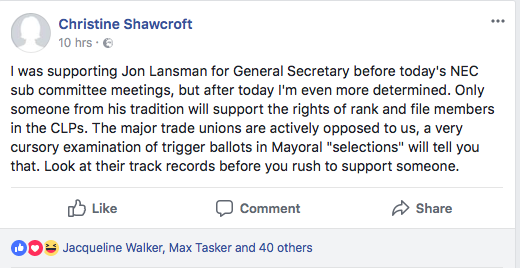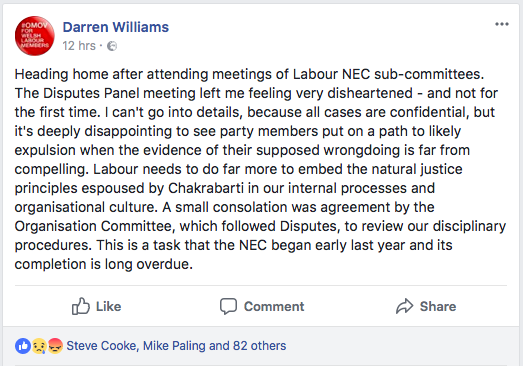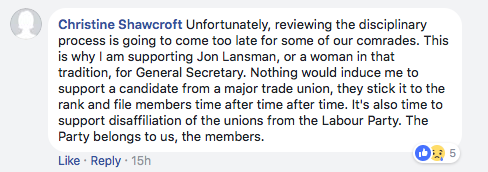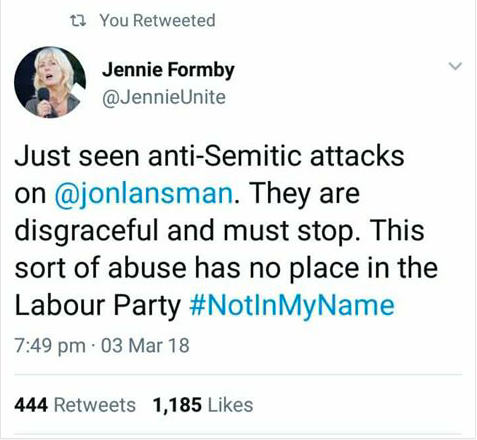Labour First, the LRC and the CLPD all vigorously oppose all-members meetings, while Momentum is in favour. But it really is a question of tactics, argues Carla Roberts
A rule change snuck through at last year’s Labour conference has led to some rather heated debates. It allows Constituency Labour Parties to switch easily from a delegate-based general committee (GC) to an all-members meeting format (AMM) – and vice versa. A number of CLPs have recently used the rule to abandon their GC and establish meetings where every single member can show up and vote. Many more CLPs are in line to follow soon, as it is immensely popular, seen by many as a measure to support the Corbyn leadership.
Critics warn, however, that the AMM structure “undermines the rules of trade unions, abandons the spirit of collectivism and breaks the principle of representative democracy that Labour has held dear for a century”. This could have been written by the Labour Representation Committee (LRC) or the Campaign for Labour Party Democracy (CLPD), which both oppose the rule. But it is actually part of an article by Matt Pound, organiser of Labour’s most rightwing faction, Labour First. Something that unites the extreme right of the Labour Party with traditional Labour left organisations certainly deserves a closer examination.
At the 2018 conference, few people paid much attention to this rule change. That was mainly down to the fact that delegates and visitors had little time to study in full detail the proposals contained within the Democracy Review: the party’s national executive committee, meeting a week before conference, had gutted the document of most of the constitutional changes originally proposed by Katy Clark (ie, Jeremy Corbyn and his allies). The first that delegates saw of the proposed rule change was on the morning of the first full day of conference: it was one of the 57 such proposals presented over 35 pages in the report of the conference arrangements committee (CAC). A travesty of the kind of democracy we need in the workers’ movement.
The focus at conference was very much on the proposals to reduce the nominations needed to stand in any leadership election and, crucially, the question of how parliamentary candidates are selected. While the vast majority of delegates were clearly in favour of the reintroduction of a system of mandatory reselection of all candidates (aka open selection), the NEC pushed for a far less democratic reform of the trigger ballot instead.
Now even this reform seems too radical for the NEC to actually implement. In January, Jennie Formby was commissioned to produce guidelines and a timetable, without which no such ballots can take place. But then Chuka Umunna and co split from the party and the leadership got cold feet. Despite the fact that the departure of Umunna et al can hardly be described as unfortunate, the mere possibility of further splits, perhaps led by Tom Watson, is regarded as a threat by Corbyn. Despite all the evidence to the contrary, he still seems to believe that he can win over the right.
In our view, the sooner those saboteurs in the Parliamentary Labour Party are gone, the better. As long as they dominate the PLP, Corbyn has very little chance of doing anything. More importantly, we need to get rid of the right if we actually want to be able to make some of the radical and democratic changes that are so desperately needed to transform the party into a powerful weapon of the working class.
However, it seems that this is not the only one of its own rule changes that the NEC has had second thoughts about.
For decades, CLPs were organised exclusively on the basis of the general committee, which is still how about half of them operate today (we are guessing here, as there are no official figures on this): local Labour branches elect delegates according to their membership figures, while trade unions and socialist societies can send one delegate for each of the branches that is affiliated locally. Trade unions have made full use of this rule, affiliating several of their branches, even if they do not actually meet or do anything – it seems that sometimes such branches have been set up explicitly for this sole purpose.
For example, since Corbyn’s election, the GMB has made huge efforts to affiliate at least one of its branches to every single Labour branch in the country, while the Jewish Labour Movement is trying to affiliate to every CLP. The purpose is clear: to oppose the left at every opportunity and support those MPs and local politicians who support the affiliate’s particular political agenda. The GC structure gives affiliates a good deal of power.
This started to change under Tony Blair in the late 1990s. Proposals to introduce all-members meetings were presented as a way to “empower the members”, when in reality they were part of the efforts to curtail the power of the unions throughout the party. Understandably, the unions strongly opposed the proposals – in this they were supported by Tony Benn and the Campaign for Labour Party Democracy (CLPD).
In 2012, Ed Miliband introduced reforms that allowed a CLP to switch between CG and AMM at its annual general meeting, where the change to the local constitution was subject to a two-thirds majority vote. This was mainly down to the fact that under Tony Blair the Labour Party not only lost tens of thousands of members; but many of those who had retained their membership did not bother showing up at meetings any more. Most CLP meetings were poorly attended, boring and utterly uninviting (yes, they were even worse than today’s).
The survey carried out by Katy Clark at the beginning of the Democracy Review in 2018 showed that, out of the 208 CLPs who participated, 141 already had an all-members structure, while 67 were based on a general committee. She reported that, “In general, in most cities” CLPs tend to have a GC structure, while “in some areas where there are AMM structures” no local branches exist.1)http://labour.org.uk/wp-content/uploads/2018/09/Democracy-Review_.pdf, p33
Delegates
According to the rule change passed at the 2018 conference then, any party unit (ie, either a branch or an affiliated organisation) can move a motion proposing to change the method of organisation – ie, to switch either to AMM or GC (the Labour Party rulebook actually allows for alternative methods beyond that, but that is very uncommon). A special CLP meeting then has to be called, in which all local members and delegates of affiliated organisations can participate. The decision to switch now requires only a simple majority of all those present. 2)Labour Party rule book 2019, clause IV, point 1.C (p40)
The vast majority of union delegates at conference 2018 – as always, under strict orders from their leaderships – voted in favour of this rule change, as part of the NEC’s tame reform package. However, it seems that it then started to slowly dawn on the unions that this was, in fact, potentially a rule change that could reform them out of any meaningful existence, when it comes to CLPs.
And it is true: in all-members meetings, the role and power of a delegate from a local union is dramatically reduced, compared to their role in a delegate-based GC. In fact, a union delegate has the same rights and voting power as any local party member, when previously a single union delegate could hold as much power as a whole Labour branch.
In November 2018, two months after conference, Unions Together (previously the Trade Union and Labour Partly Liaison Organisation – TULO), which represents the 12 affiliated unions, came out against the rule change in a short statement:
Trade unions support delegate-based structures for CLPs, because they allow TU branches that have affiliated to a CLP to be formally represented and take part in the CLP’s decision-making processes. All-member meetings do not allow affiliated TUs to be represented in CLP decision-making, and this weakens the relationship between the party and the unions at the local level.
We also believe that the unions are playing a part in delaying the implementation of the reformed trigger ballot, as this would further reduce their power in the party. For the first time, the trigger ballot has been split into two – one for all organisations affiliated to the CLP and one for all branches. That means Labour members can choose to challenge the sitting MP (if one third of all local branches vote in favour of doing so) and cannot be blocked by delegates from local affiliates. However, affiliated organisations are unlikely to initiate a trigger ballot. Their role in this process has tended to be mainly a negative one – ie, often it has been local union bureaucrats who have voted against challenging a sitting MP.
This does rather beg the question as to how, firstly, those two rule changes made it into Katy Clark’s Democracy Review and then, secondly, got past the NEC, which gutted it of many other suggestions. After all, 13 of the 39 members of the NEC are representatives from the affiliated unions, with a couple of other members (like treasurer Diana Holland) having been ‘seconded’ by them. They represent a hugely important bloc and usually vote together (just as they do at conference). Did they simply take their eye off the ball?
And who had been pushing for these changes in the first place? Katy Clark was working closely with Jeremy Corbyn – did they really set out to take on the unions? Yes, the union bloc has often acted as a barrier to progressive change in the party. But the biggest affiliate is still Unite and Len McCluskey remains a loyal supporter of Corbyn. Corbyn and Clark surely would not have pushed for these two changes without McCluskey’s say-so.
Perhaps this move indicates a split within the unions between those who support Corbyn and those who are currently led by rightwingers, such as the GMB, Unison and Community. That would be very welcome indeed. But we are guessing here. As is unfortunately often the case in the labour movement, these arguments are not fought out in the open, in front of the membership, but treated like a dirty secret and kept away from the working class.
We do know, however, that a certain Jon Lansman has certainly set out to curb the power of the unions in the party – no doubt in order to increase his own. The less power the unions have, the larger Momentum looms. This became most obvious when his then ally, Christine Shawcroft (whom he made director of Momentum on January 10 2017: ie, the day of his coup within the organisation), publicly supported his short-lived campaign to run against Unite’s Jennie Formby for the position of general secretary:
I was supporting Jon Lansman for general secretary before today’s NEC subcommittee meetings, but after today I am even more determined. Only someone from his tradition will support the rights of rank-and-file members in the CLPs. It is time to support disaffiliation of the unions from the Labour Party.
The reason she gave for that last comment was because they “always stick it to the rank-and-file members, time after time after time.”
Shawcroft clearly thought she was doing Lansman a favour by repeating what he had no doubt been going on about behind the scenes. Our Jon, however, was not best pleased and – despite dumping her like a hot potato straightaway (like he has done with so many former political friends and allies) – he was forced to withdraw his candidacy.
Momentum is, as far as we can see, the only Labour organisation that is supporting the move towards AMMs. True, among the pro-Corbyn membership this is considered ‘common sense’ – after all, the members should be in charge, right? Many local members who are pushing for AMMs are undoubtedly on the left and are doing so out of a real desire to support Corbyn’s leadership and break the ongoing hold of the right over many CLPs. In many areas, the same old bureaucracy has been running things for years and seems to have an unbreakable hold over the branches.
Local branch meetings, which select the CLP delegates, are often so boring and bureaucratic, without any debates or real life to them, that many of those inspired by Corbyn turn up once – and cannot bring themselves to go again. It is very difficult to turn around a rightwing branch that has been run by the same local clique for decades; it takes patient work and a huge amount of effort to organise the local left.
Pros and cons
The AMM structure does seem the easier way to turn things around. After all, CLP meetings are larger, you only have to attend a meeting once a month and they are more likely to feature a political discussion of some sort. It is much easier to persuade disconnected, atomised Corbyn supporters to come to a monthly AMM. This is, of course, exactly the reason why Labour First opposes the move (although Matt Pound tries to pretend that it has to do with its concern for the “gender balance” of CLP delegates, which would not be guaranteed in AMMs). In other words, in some areas it can be a good idea to push for AMMs – especially in smaller CLPs.
But there are very good reasons to be critical of them too:
- AMMs can further atomise the membership. The average size of a CLP is 850 members, but the actual local membership figures vary massively. In a small CLP, an AMM structure can allow you to meet and organise with other lefties when there might not be many or any in your branch (if there even is a branch). But in CLPs with many hundreds of members, AMMs can easily become too big to allow for any real democratic debate or decision-making. If the chair is on the right, they may not be willing to call in somebody from the left to speak, for example, making discussions very one-sided. The AGM is likely to turn into a huge jamboree, where members are supposed to vote for candidates that many might not have even heard of. This structure has the potential to make the CLP executive incredibly powerful and almost untouchable for the rest of the year. Not surprisingly, in some areas it is the local right that argues in favour of AMMs. Any AMM that involves more than, say, 70 members is clearly too big.
- AMMs undermine representative democracy. Jon Lansman is a big fan of ‘digital democracy’ and online decision-making using ‘One member, one vote’. That should tell you why real democrats must oppose it. These methods might look democratic on paper, but dig a little deeper and you will find that they are designed to keep members atomised and the leadership all-powerful. CLP delegates, like conference delegates, are – at least in theory – accountable to the people who elected them. They are supposed to represent and argue for a particular political point of view. Good delegates report back on how they voted and are then faced with criticism or support, which allows for good political debate and the education of the whole membership.
- AMM structures can demobilise the membership. They may make it more difficult for members to get involved in the day-to-day decision-making within the party. If you go to an AMM, you do not need to get involved in the local branch structures, you do not need to stand for delegate elections, you do not need to defend your voting records or your point of view. But we need our comrades to learn how to run things, to take charge, to organise and to be accountable and hold others to account. This is a crucial part of training our side up to run society in the not-so-distant future.
- AMM structures weaken the trade union link. This is where the LRC focuses its criticism: It “seriously dilutes the input of union delegates into CLPs, a dangerous step … With some on the left even questioning the union-party link at any level, it is incumbent on socialists to argue for retaining that link, while taking up the cudgels for democratisation of that union input.”
While LRC comrades are wrong to elevate support for GC structures into a principle, they are quite right to raise the need to campaign for the “democratisation of the union input”, as they put it. In fact, the whole union movement – just like the Labour Party itself – is in need of a radical, democratic transformation. Many delegates from affiliated unions and socialist societies are playing such a negative role – for example, by supporting the local rightwing MP or stopping the CLP from supporting progressive campaigns – that many Corbyn supporters are understandably tempted to throw the baby out with the bathwater.
This issue really underlines how weak the left is in its campaign to democratise the unions. This is visibly demonstrated by the fact that both the CLPD and LRC have managed merely to come out against AMMs: they are not in a position to campaign against it.
References
| ↑1 | http://labour.org.uk/wp-content/uploads/2018/09/Democracy-Review_.pdf, p33 |
|---|---|
| ↑2 | Labour Party rule book 2019, clause IV, point 1.C (p40 |
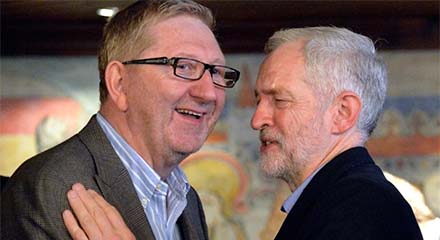
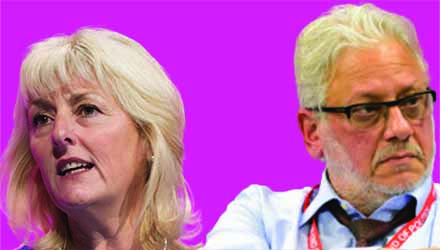
 fter all, he is Mr Momentum, which has since its inception been portrayed as a dangerous hotbed for an assortment of hyperactive hippies and Trotskyist troublemakers. He has been on the ‘far left’ of the Labour Party for decades, we are told. However, over the last 14 months, Lansman certainly has been very busy moulding Momentum into a thoroughly respectable election machine.
fter all, he is Mr Momentum, which has since its inception been portrayed as a dangerous hotbed for an assortment of hyperactive hippies and Trotskyist troublemakers. He has been on the ‘far left’ of the Labour Party for decades, we are told. However, over the last 14 months, Lansman certainly has been very busy moulding Momentum into a thoroughly respectable election machine.